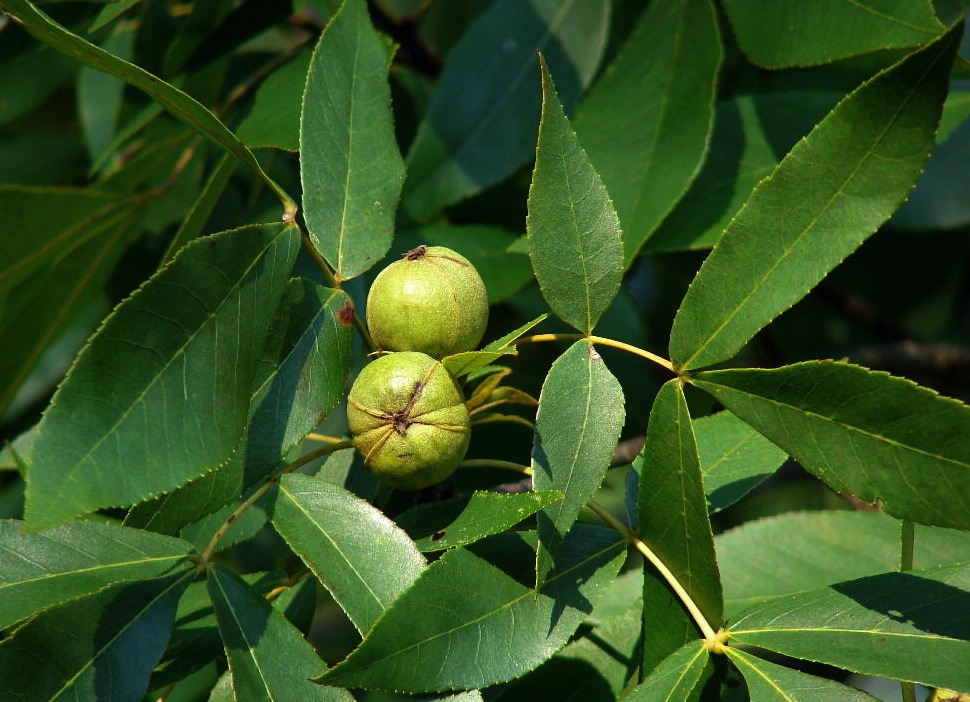
Pignut Hickory, most common on the drier soils of slopes and ridge tops, but also grows on moist upland.
It’s time to go nuts! While out identifying shelf mushrooms — not an easy task — I noticed the hickories are shedding… one dropped on me. They hurt more than acorns which are also raining. Hickories and pecans are closely related, as are walnuts and butternuts, all variations on a theme scattered across North America. Butternuts — a northern species — were the favorite of my mother whereas I prefer hickories, quite common here in Florida. The headache with this clan is shelling them.
Ma Nature knows these nuts pack a lot of good stuff so she makes the nuts hard to crack. In the middle is the nutmeat. That is surrounded by a woody shell. The shell is wrapped in a tough, skin-staining husk. Man has invented many way to get at the nutmeat, all require labor. This ranges from pounding up the entire dehusked nut and soaking the mash in water to running over them with a car (do not have anyone standing around should you try this because the nut can be squeezed between the edge of the tire and the ground and shoot out injuring hungry bystanders.) You can also use a nutsheller, manual or electric. More on that in a moment. Two fairly common hickories locally is the Water Nut Hickory, which is bitter but can be leeched. The other is the Pignut Hickory. The name is not an editorial on the taste but rather the shape of the distribution of the nutmeat within the nut. It resembles a pig’s snout. Further north Shagbark hickories are common.
Acorns are like the phrase from the old song, My Momma Told Me You Better Shop Around. At a Starbuck’s near me there are several young oaks of the same species, all about the same age. All have produced acorns this year (usually oaks make acorns every other year.) Out of the seven Starbuck oaks one has acorns with almost no tannic acid. A few at a time can be eaten out of hand. So this past week with my large, decaffeinated iced coffee in hand I sat down for an hour amidst busy traffic and finger-picked 11 pounds of acorns. They’re long and skinny, small capped, two-toned.
Oak nuts shell easier if they dry a little. That means green ones shell the hardest. But, if they dry too long, such as on the ground, weevils get a chance to lay eggs in them and/or the acorns get damp and begin to turn bad. The key is to watch the tree and harvest new brown ones, either off the ground or off the tree. The next step, after a quick dunk in water to eliminated compromised ones, is to dry them with gentle, low heat, read in the sun or in an oven heated only by a pilot light. This causes the nut to shrink a little inside the shell making it easier to remove. As the weather has been cool for Florida, and my aging solar oven leaks a little if I don’t clamp down the top, I used the solar oven to “dry” the acorns.
Shelling comes next, which is the labor intensive, it-takes-a-village part of using acorns. A nut sheller makes the job much easier and can be adjusted to accommodate round acorns or skinny ones. I think there is only one supplier in the United States, DaveBilt. It’s literally a family business and this time of year they tell me their shellers are about three weeks on back order. You can also shell acorns manually which is a good job for little hands with destructive energy. The cap end is soft and is easily split entering at that point. There was one odd thing while collecting the acorns pictured above. In a two-toned sea of long acorns there was a mono-colored one with a very small cap (left photo) directly below the tree with no different species around. Is it a mutation? Is it galled? I’m going to plant it just to see what happens. I might live long enough to see what kind of acorns it could produce. That’s optimism. But just in case I will leave it in my will to some much younger plant person for stewardship. To learn more about acorns there’s an article here and a video here.
The mail this week brought an interesting question about making tea out of the Bidens alba (article, video) aka Spanish Needles, Begger’s Ticks, Pitchfork Weed. Can it be used like regular tea? The general answer is no but… As an herbal tea it is more on the medicinal side than refreshing side. Ah, but what an herbal tea. Herablist Henriette Kress writes about the many virtues of Bidens tea in her latest book, Practical Herbs. Importantly, she tells us all Bidens can be used the same way. Applications include digestive and respiratory issues, urinary tract infections, benign prostatic hyperplasia, hay fever and gout. Though medicinal it can be taken daily.
How do you make the tea? Cut down a large collection of Bidens in full flower. Make them into a loose bundle and hang up to dry out of the sun but with circulating air. You don’t want them to mold. Also, and I know from personal experience, keep them out of the reach of cats who find the species interesting. Once thoroughly dry crumple leaves, seeds and small stems together (discard large stems.) This is your basic material for tea. Use one or two teaspoons of the dry material in a cup of boiling water, steep 10 minutes, drink three to four cups daily. The flavor of Bidens alba tea is very close to green tea.
Don’t forget about the Florida Herbal Conference this February 15-17 and the discount you can get by signing up early and by using the code EATTHEWEEDS. If you register by Dec. 15th and use EATTHEWEEDS that’s a 20% discount. For more information go to: Florida Herbal Conference.
It’s an old story, been around some 80 years: Scientists say bumblebees can’t fly. However man-made dragonflies can. Before we get to the dragonflies what about the aerodynamically-challenged bumblebee? The story has two sources, a dinner conversation in Germany or a book in French about insects. The problem in each case the engineers who did the calculating viewed the bee as a fixed-wing object which would make them flightless. However, their wings are more like helicopter blades, to be more precise, reverse-pitch semirotary blades. A moving wing generates a lot more lift than a stationary one thus bumblebees do indeed fly. That’s also how artificial dragonflies fly.
The Techjet Dragonfly is an “unmanned autonomous vehicle” (UAV) that flies, hovers and can collect data with its onboard sensors. The Dragonfly was developed at Georgia Tech with a million dollars from the Air Force. The design has four wings and is a little larger than a real dragonfly, measuring six inches long and weighing 25 grams, which is just shy of an ounce. Power is supplied by a 250 mAh lithium polymer battery providing hover times of 8 to 10 minutes and a combined hover/flight time of 25 to 30 minutes. They also have up to 20 environmental sensors and cameras as well as GPS capabilities. The Dragonfly can provide live and mobile feed for photography, security, gaming, spying and swarm robotics. They will soon be available in four models: Alpha ($250) is the basic model. Delta is faster and will cost $500. Gamma has more programmable features and a price tag of $750. The Omega model is the fully-loaded dreadnaut dragonfly going for $1,499. What I want to know is will birds leave them alone, or, will we need mechanical birds to keep those robotic swarms in check?
“Swarm Robotics” is fairly clear in concept but fuzzy in application. It’s a lot of simple, cheap little machines, doing something better than a large, expensive one. Got it. Applications are more jargon than practical at the moment. However, I can think of one: If honeybees do indeed die off we will need something to pollinate plants, and make honey. More importantly will you be bothered at some future picnic by a mechanical bee trying to steal some jelly? You could swat it but Big Brother Beekeeper has a video of you and knows exactly where you are. Time to arm the deadly nerve gas stinger…
And this just in: Dateline: Placer County California, Nov 11, 2012: Much of this information came from an article in the Scaramento Bee written by Peter Hecht:
Two residents of a senior care facility died and four other people were hospitalized after consuming soup with wild mushrooms harvested by a caregiver, the Placer County Sheriff’s Department reported.
Sheriff’s Lt. Mark Reed said Saturday that deputies were called at 10 a.m. Friday to the Gold Age Villa, a care home for the elderly on a rustic, tree-shaded property, tucked amid a community of equestrian estates along Horseshoe Bar Road.
“We got a report that some people had consumed some poisonous mushrooms,” Reed said. “We responded out to the facility and interviewed people to make sure there was no foul play. There wasn’t any … It was an accident.”
Reed said a caregiver who prepared the meal with the mushrooms was among the six people sickened. The two residents who died were identified as Barbara Lopes, 86, and Teresa Olesniewicz, 73, he said. The caregiver and three residents were hospitalized, he said.
Reed called the event a tragedy, in which the caregiver “just didn’t know” the mushrooms were poisonous. Last year, the California Department of Public Health warned that collecting and eating wild mushrooms can cause cramping, vomiting and diarrhea as well as liver and kidney failure. According to state data, there were more than 1,700 reported cases of mushroom ingestion in California in 2009 and 2010. They included 10 cases of serious poisoning and two deaths, including an 82-year-old Santa Barbara man who gathered wild mushrooms to sauté with his steak.
While the type of mushrooms consumed in the Loomis tragedy were unknown, two varieties commonly found in California – the Amanita ocreata and Amanita phalloides, dubbed the “destroying angel” and “death cap,” respectively – are considered particularly dangerous.
Dr. Todd Mitchell, a Santa Cruz, Calif., who is investigating an antidote to toxic mushroom poisoning, told NBC News that he is consulting on treatment of one of the patients sickened by the mushrooms which shut down liver function.
The woman, who is in her 90s, is being treated with the so-called “Santa Cruz protocol” that includes use of the investigational drug Legalon, an intravenous form of silibinin, which is the extract of seeds from the milk-thistle plant. The extract prevents the toxins from reaching the liver.
The treatment started Friday night, so it’s still too early to tell how the woman, who was not identified, will fare, Mitchell said. However, dozens of patients treated with the milk-thistle drug and a protocol that emphasizes aggressive hydration typically have improved within 48 hours, he said.
Nationwide, nearly 6,000 people reported contact with suspicious mushrooms in 2010, and more than 1,300 people got sick, according to latest figures from the American Association of Poison Control Centers. Some 500 people suffered moderate to major injuries and at least one person died.
The deadly Amanitas are well represented here in the south and Florida. One local Amanita, however, is edible, the Amanita jacksonii aka A. umbonata. Do NOT rush out and try one. Get someone to positively identify it first.
To donate to the Green Deane Newsletter click here.

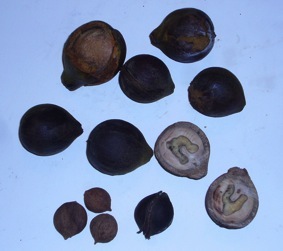
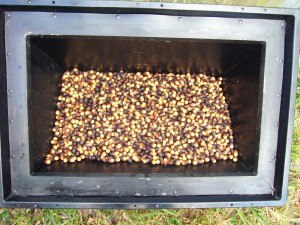
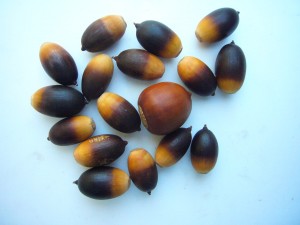
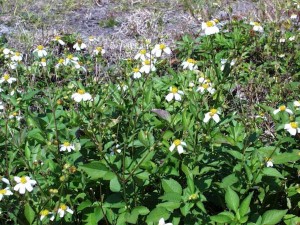
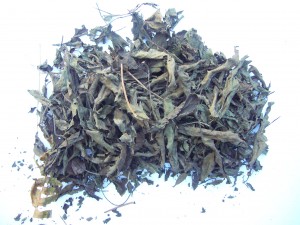
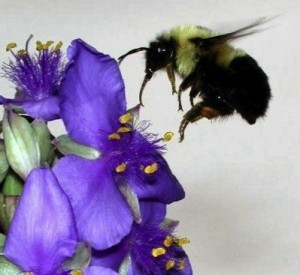

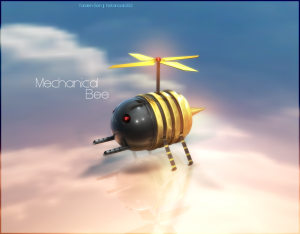

Green Deane, thank you for again putting up more Bidens info – I think that rather than make my usual half-hearted attempt at growing my veggie garden this year, maybe it would be better to just encourage a full patch of Bidens alba in the back yard! And this would be a good year to try an acorn harvest, thanks to your newsletter and the abundance of the little missiles pelting me in the head. 😉
Funny! After learning their nutritional value I let them come up with my other vegetables now and throw them in with salads 🙂
Kim
Thanks for another interesting informative newsletter. I have family in Florida, and I must tell them to watch for a bearded man harvesting acorns when they are at their local Starbucks.
Unfortunately the oaks in my backyard are on a ‘bye’ year, I guess. In years past, we’ve been awakened during the night by the hard little sounds of acorn ‘missles’ (thanks, Sandy Brown!) falling off the trees and onto our wooden deck. Not this year. I don’t remember them dropping last year, either. And on the poisoning article, thank you for putting in additional information. The news item about the poisoning is all over the ‘Net but I haven’t seen any references to the treatment, esp. with milk thistle. Really good article Dean. Thank you! (p.s. I think you cautioned folks to generally stay away from wild ‘shrooms, and that’s exactly what I do!)
You mentioned shagbark hickory….I make a tea from the bark itself, then add sugar and boil it to make syrup for pancakes. Rather tasty, and I prefer it to Maple syrup! (Don’t tell my step-dad, his family has a maple syrup business!)
db
do you know which of the acorns of the many oak species in No CA are edible/good eating? we have lots of acorns this year–the crows are going crazy!
we have Blue Oak, White Oak, Live Oak (evergreen), Canyon Oak (evergreen), among others..
thanks!
The should all be good but taste around, you want to work with ones with the least tannins.
The skinny acorns appear to be from a live oak, and the odd one looks like water/laurel oak . I bet a squirrel was messing around with you.
Sir , besides the useful knowledge I have gained , my comments should not ignore the following basic educational goals which I hope teachers in parti-cular may bequeath their learners : 1- intimacy with nature , 2- being a good observer (the odd acorn) ; this is how SCIENCE advances . 3- The importa-nce of analogies in the learning process (bumblebees and dragonflies) ;it re-minds me of the first burial in human race history of a dead human – Adem-s son by his other son when watching the crow digging the soil (story in Kor-an holy book).
I also like to see people look optimistic (to live and see what happens after planting the odd acorn) . This, too, is riminiscent of the date palm seedling in the hands of a planter within just the instant of falling Resurrection Day . According to religious teaching ( Islam ) the person should think of nothing except of trasplanting the seedling and that should be even before leaving the place where he was . All this is meant for the benefit of others . Best regards
No reference I have says Salvia riparia is consumable.